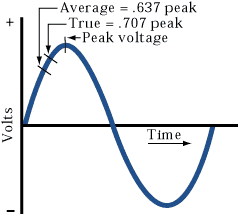The Benefits of Using a “True-RMS” Multimeter
Although virtually all multimeters measure AC voltage, only a true-RMS (root-mean-square) multimeter instantly measures the actual amount of voltage supplied to exposure lamps and other copier parts and systems that operate on AC voltage. This actual voltage is referred to as true-RMS. Adjustments made to AC voltage supplied to such parts and systems must be based on true-RMS. A “non-true-RMS” multimeter, however, determines only the average amount of AC voltage supplied to a specific part. A service technician must convert this average to true-RMS in order to make accurate AC voltage adjustments. By using a true-RMS multimeter, a service technician increases service call efficiency, while preventing errors that can result in improper adjustments, poor copy quality, premature parts failure, and/or machine damage.
True-RMS vs. Average Measurements
AC voltage from a wall outlet reverses its polarity at regular intervals. Between polarity reversals, AC voltage varies in magnitude (strength). When polarity is positive, voltage steadily increases to its peak and then steadily decreases to zero. Polarity then reverses to negative, and AC voltage magnitude mirrors the positive variations. Plotted on a graph, these polarity reversals and magnitude variations form a sine wave (see figure 1).

Figure 1. To properly adjust the AC voltage supplied to a specific part, a service technician must base the adjustment on the true-RMS value of AC voltage, not its average value. For standard U.S. voltage (120 VAC), true-RMS is .707 of the sine wave’s peak, while the average is .637 of the peak.
For a standard U.S. AC voltage sine wave, true-RMS is .707 of the peak. True-RMS is always higher than average AC voltage, which is .637 of the peak. For example, with a peak of 170 VAC, true-RMS is 120 VAC, whereas the average is 108 VAC.
A true-RMS multimeter contains more sophisticated circuitry that samples the AC voltage sine wave and measures its actual value. A non-true-RMS multimeter contains less sophisticated circuitry that samples only the peaks of an AC voltage sine wave to determine an average.
When using a non-true-RMS multimeter, a service technician must determine true-RMS by either: 1) manually completing time-consuming mathematical conversions, or 2) using an OEM-supplied reference chart. Such charts, however, are only supplied by some OEMs, and are often difficult to use effectively. Either option requires additional service time, and can result in errors leading directly to improper voltage adjustments.
Consequences of Incorrect Adjustments
Today’s sophisticated copiers are designed with many interrelated, interdependent electrical systems. Consequently, incorrectly adjusting the AC voltage supplied to one part often starts a “domino effect,” adversely affecting the performance and life of other critical machine parts and systems, as well as copy quality.
For example, suppose a service technician uses a non-true-RMS multimeter to check the voltage supplied to an exposure lamp rated at 80 VAC. He receives a reading of 57 VAC, which indicates the average voltage. If the service technician mistakenly uses this average to make an adjustment, he will increase the supplied voltage to reach 80 VAC (the lamp’s rating). However, this voltage adjustment is not based on true-RMS; the actual, true-RMS voltage being supplied to the lamp is now 103 VAC– too high for proper operation. If he used a true-RMS multimeter instead, or converted the 57 VAC reading to true-RMS before making an adjustment, he would have discovered lamp voltage was already set properly at 80 VAC. Conversion errors are actually more common than forgetting that conversion is necessary, but the results are similar: improper voltage adjustments that can adversely affect numerous machine parts and systems.
Supplying excessive voltage to an exposure lamp not only can cause light copies, it can cause the lamp’s filament to burn out prematurely, and also require the voltage regulator to work harder. In addition, other systems in the machine (e.g., drum charge in a copier with automatic compensation controls) attempt to compensate for higher lamp voltage, and the parts making up these systems can fail prematurely. Costly troubleshooting time may be required to resolve these problems, because the service technician must work backward to the problem’s ultimate source.